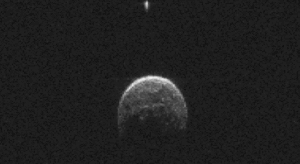(357439) 2004 BL86
|
| |
| Discovery[1] | |
|---|---|
| Discovered by | LINEAR (704) |
| Discovery date | 30 January 2004 |
| Designations | |
| MPC designation | (357439) 2004 BL86 |
|
Apollo NEO, PHA[2] | |
| Orbital characteristics[2] | |
| Epoch 13 January 2016 (JD 2457400.5) | |
| Uncertainty parameter 0[2] | |
| Observation arc | 4084 days (11.18 yr) |
| Aphelion | 2.1069 AU (315.19 Gm) |
| Perihelion | 0.89754 AU (134.270 Gm) |
| 1.50223 AU (224.730 Gm) | |
| Eccentricity | 0.40252 |
| 1.84 yr (672.52 d) | |
| 208.11194° | |
| 0° 32m 7.094s / day | |
| Inclination | 23.77604° |
| 126.70921° | |
| 311.44162° | |
| Known satellites | 1[3] |
| Earth MOID | 0.00810452 AU (1,212,419 km) |
| Jupiter MOID | 3.24294 AU (485.137 Gm) |
| Jupiter Tisserand parameter | 4.364 |
| Physical characteristics | |
| Dimensions | 325 m (1,066 ft)[3] |
| 2.6205 h (0.10919 d) | |
| V-type asteroid[4] | |
| 19.3[2] | |
|
| |
(357439) 2004 BL86,[5] provisionally known as 2004 BL86, is a near-Earth asteroid estimated to be about 325 meters (1,066 feet) in diameter.[3] It was discovered on 30 January 2004 by LINEAR.[1] It passed 1,199,600 km (745,400 mi), or 3.1 lunar distances, from Earth on 26 January 2015 at 16:20 UTC.[5][6] During the 2015 approach it was determined to have a satellite.
2015 Earth approach
On 26–27 January 2015, the asteroid briefly peaked around apparent magnitude 9 and was near the celestial equator.[7] The asteroid was visible in telescopes with objectives of 100 mm (4 in) or larger; high-end binoculars under a dark sky may also have worked.[8] Near closest approach the asteroid was moving about 2.5 degrees per hour (2.5 arcseconds per second).[7][9] The asteroid came to opposition (furthest elongation in the sky from the Sun) on 27 January 2015 at 04:37 UTC.[7] Around 5:00 UTC, the asteroid was near M44 (the Beehive Cluster).[9]
26 January 2015 approach of 3.1 lunar distances was the closest approach of 2004 BL86 for at least the next 200 years.[5][6][10] For comparison, 2015 TB145 about twice the size of 2004 BL86, passed 486,800 km (302,500 mi), or 1.3 lunar distances, from Earth on 31 October 2015.[11]
Satellite
A satellite was first detected by ground-based telescopes by Joe Pollock and Petr Pravec.[12] Observations by the Goldstone Deep Space Communications Complex and Green Bank Telescope confirmed that it is a binary asteroid with a secondary roughly 70 meters (230 feet) across.[3] The secondary is estimated to orbit at least 500 metres (1,600 ft) from the primary.[13] About 16% of asteroids over 200 metres (660 ft) in diameter are thought to be binaries.[3]
Gallery
-

Asteroid 2004 BL86 safely passes Earth on 26 January 2015
-

Trajectory of 2004 BL86 during Earth close approach
-

2004 BL86 (star trail on left) near Xi Puppis
References
- 1 2 "MPEC 2004-B80 : 2004 BL86". IAU Minor Planet Center. 31 January 2004. Retrieved 7 June 2014. (K04B86L)
- 1 2 3 4 "JPL Small-Body Database Browser: 357439 (2004 BL86)" (last observation: 20 December 2014; arc: 10.89 years). NASA/Jet Propulsion Laboratory. Retrieved 8 April 2016.
- 1 2 3 4 5 Agle, D. C. (26 January 2015). "Asteroid That Flew Past Earth Today Has Moon". NASA. Retrieved 26 January 2015.
- ↑ "PSI Scientists Study Surface Composition of Asteroid 2004 BL86 During Close Flyby of Earth". Planetary Science Institute. 27 January 2015. Retrieved 28 January 2015.
- 1 2 3 Agle, D. C.; Brown, Dwayne (13 January 2015). "Asteroid to Fly By Earth Safely on January 26 [2015]". NASA. Retrieved 13 January 2015.
- 1 2 "JPL Close-Approach Data: 357439 (2004 BL86)" (last observation: 12 March 2013; arc: 9.11 years). NASA/Jet Propulsion Laboratory. Retrieved 7 June 2014.
- 1 2 3 "(357439) 2004BL86 Ephemerides for 25 January 2015 through 29 January 2015". NEODyS. Retrieved 7 June 2014.
- ↑ Musgrave, Ian (23 January 2015). "Seeing the Close Flyby of NEO 2004 BL86 26 - 27 January, 2015". Retrieved 28 January 2015.
- 1 2 MacRobert, Alan (22 January 2015). "Mountain-size Asteroid Glides Past Earth". Sky & Telescope. Retrieved 23 January 2015.
- ↑ Busch, Michael (7 February 2015). "Final post-flyby update...". Twitter.com. Retrieved 7 February 2015.
- ↑ "JPL Close-Approach Data: 2015 TB145" (last observation: 1 November 2015; arc: 22 days). NASA/Jet Propulsion Laboratory. Retrieved 2 December 2015.
- ↑ "Image Release: High-Def Radar Images of Near-Earth Asteroid". National Radio Astronomy Observatory. 30 January 2015. Retrieved 30 January 2015.
- ↑ Busch, Michael (28 January 2015). "Will require combined analysis...". Twitter.com. Retrieved 7 February 2015.
External links
| Wikimedia Commons has media related to (357439) 2004 BL86. |
- Orbital simulation from JPL (Java) / Ephemeris
- Sky & Telescope B/W finder chart
- (357439) 2004 BL86 at the JPL Small-Body Database



